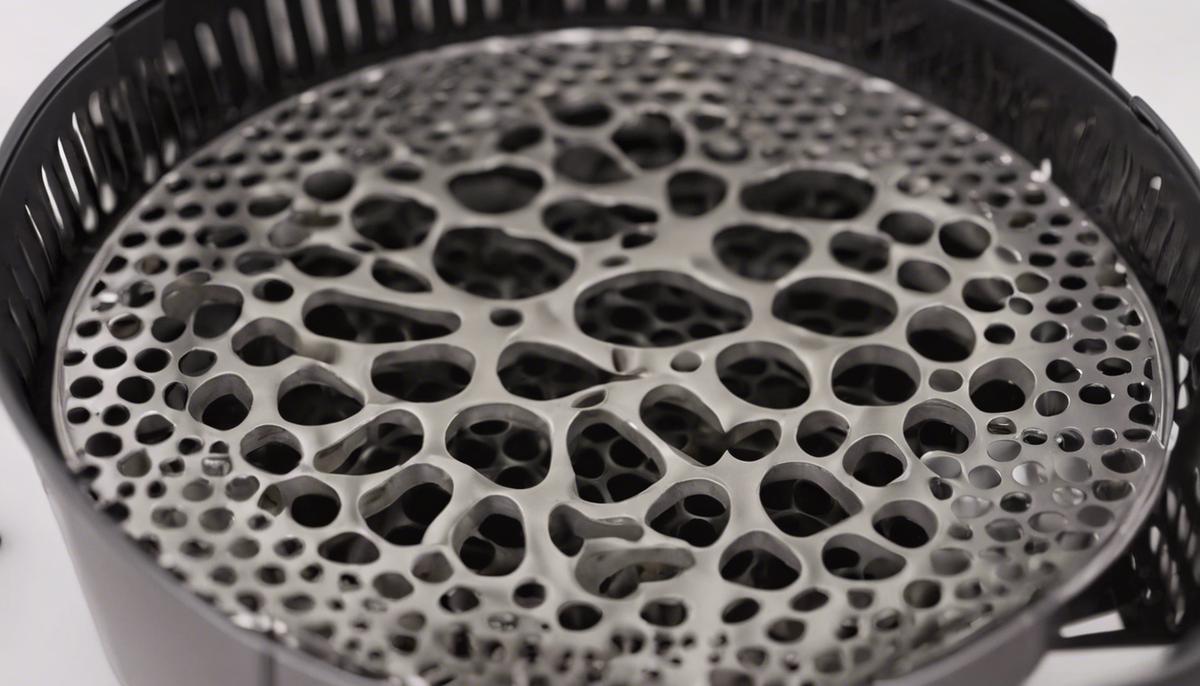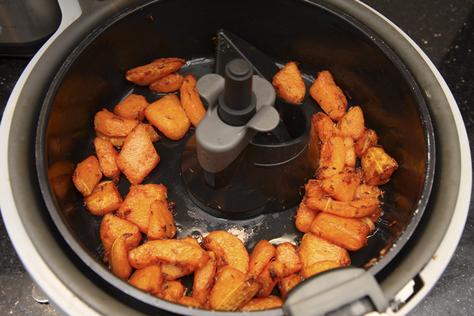Understanding Air Fryer Mechanics
Air fryers differ from traditional ovens through their use of rapid air circulation technology. These kitchen devices circulate hot air around the food at high speed, cooking it quickly and evenly with a crisp exterior. Here's what you need to know about air fryer mechanics.
Temperature control is important in air fryers. They allow for setting specific cooking temperatures, but due to their efficient design, they generally require a lower temperature setting than ovens–usually by about 25°F. This adjustment prevents exterior burning while ensuring that the inside is fully cooked.
The fan in the air fryer plays a key role. Positioned at the top and paired with a heating mechanism, this fan pushes hot air downwards and rapidly around the food placed in the basket. The enclosed design of an air fryer ensures concentrated and strong air movement, leading to faster cooking times.
Air fryer baskets are designed to promote airflow. The holes in these baskets allow air to flow beneath the food, ensuring all sides are exposed to the same intense heat. This is why foods like French fries and chicken wings come out uniformly crisp and evenly cooked from an air fryer.
To use an air fryer correctly, appreciate its design for rapid air circulation, understand that temperature settings do not translate directly from conventional ovens, and recognize that the basket's structure helps ensure even cooking. Adapting to these principles will ensure crispy, well-cooked meals every time.

Converting Oven Recipes to Air Fryer
Adapting your oven recipes for the air fryer often means quicker cooking times and a delightfully crispy finish. Here's how to modify your kitchen classics so they turn out great in your air fryer.
- Temperature Adjustment: Air fryers cook at a more intense rate due to their compact design and high-speed air circulation. Reduce the oven's suggested temperature by about 25°F. For instance, if your recipe requires baking at 375°F, adjust it to 350°F for the air fryer.
- Time Reduction: Cook times are typically around 20% shorter in the air fryer. If your chicken usually bakes for 30 minutes, aim for about 24 minutes in the air fryer. Start checking a few minutes before the timer goes off to prevent overcooking.
- Batch Cooking: Air fryers work best when they aren't crowded. Place your food in a single layer and avoid stacking to ensure even crispiness and proper heat distribution. You may need to cook in batches, but the quick cooking time makes this manageable.
- Prep Changes: For foods that need coating or moistening, minor changes may be needed. A light brushing of oil might be required on breaded items to encourage that golden crisp. Flipping halfway through cooking ensures even exposure to the heating element.
- Check Doneness: Use an instant-read thermometer to check if meats are cooked properly according to safe internal temperatures, as every air fryer model can differ slightly.
Feel free to tweak quantities and durations as you learn how your specific air fryer model behaves. This tailored approach means you'll soon be serving up perfectly adapted dishes that impress with their taste and texture.
Achieving Perfect Results with an Air Fryer
Preheating is crucial to ensuring perfectly cooked meals in your air fryer. Warm up your air fryer for about three minutes before adding your food. This essential practice brings your machine up to the ideal temperature so cooking begins promptly and uniformly.
Avoid overcrowding the air fryer basket. Air fryers work by circulating hot air around the food. Overpacking prevents air from reaching all parts of the food equally, leading to uneven cooking. Arrange items in a single layer with some space between them. If cooking larger batches, do so in rounds.
Air fryers can handle a wide range of foods. They excel with vegetables, giving them a delightful crunch. They're also great for proteins like chicken thighs or fish fillets, creating a crispy outside while keeping the inside moist and tender. You can make fresh homemade fries that come out golden and crisp, or even air fry fruit slices for a quick, caramelized dessert.
Different foods and recipes will require adjustments in both cooking times and temperatures. The optimal settings depend on the desired texture and taste. If something's not quite right on your first try, adjust the temperature or cook time for your next attempt. Fine-tuning these elements can have a big impact on your final dish.
Air fryers offer creative freedom in the kitchen. You can lightly toast nuts or seeds for salads and breakfast toppings, or revive day-old donuts with a quick spin in the basket. These highlight the appliance's versatility.
Learning to cook effectively with an air fryer involves following guidelines and embracing experimentation. Explore and push its boundaries to elevate the flavors and textures of your meals. Your trusty air fryer awaits your next tasty creation.

In mastering your air fryer, remember that preheating is a crucial step not to be overlooked. This simple act ensures that your meals are cooked evenly and start at the optimal temperature, setting the stage for perfect results every time.
Get high-quality AI content with Writio, the ultimate writer for website publishers and blogs. This article was written by Writio.
- Kita H, Weissman J, Callahan M. Adapting Recipes for Air Fryer Cooking. J Am Diet Assoc. 2021;121(11):2133-2136.
- Nguyen T, Chen J, Ahn J. Optimizing Air Fryer Performance for Crispy and Healthy Cooking. Food Sci Technol Int. 2020;26(7):567-575.
- Patel R, Singh A, Kumar S. Impact of Air Frying on Nutritional Quality of Foods: A Review. Trends Food Sci Technol. 2019;86:230-241.
Leave a Reply